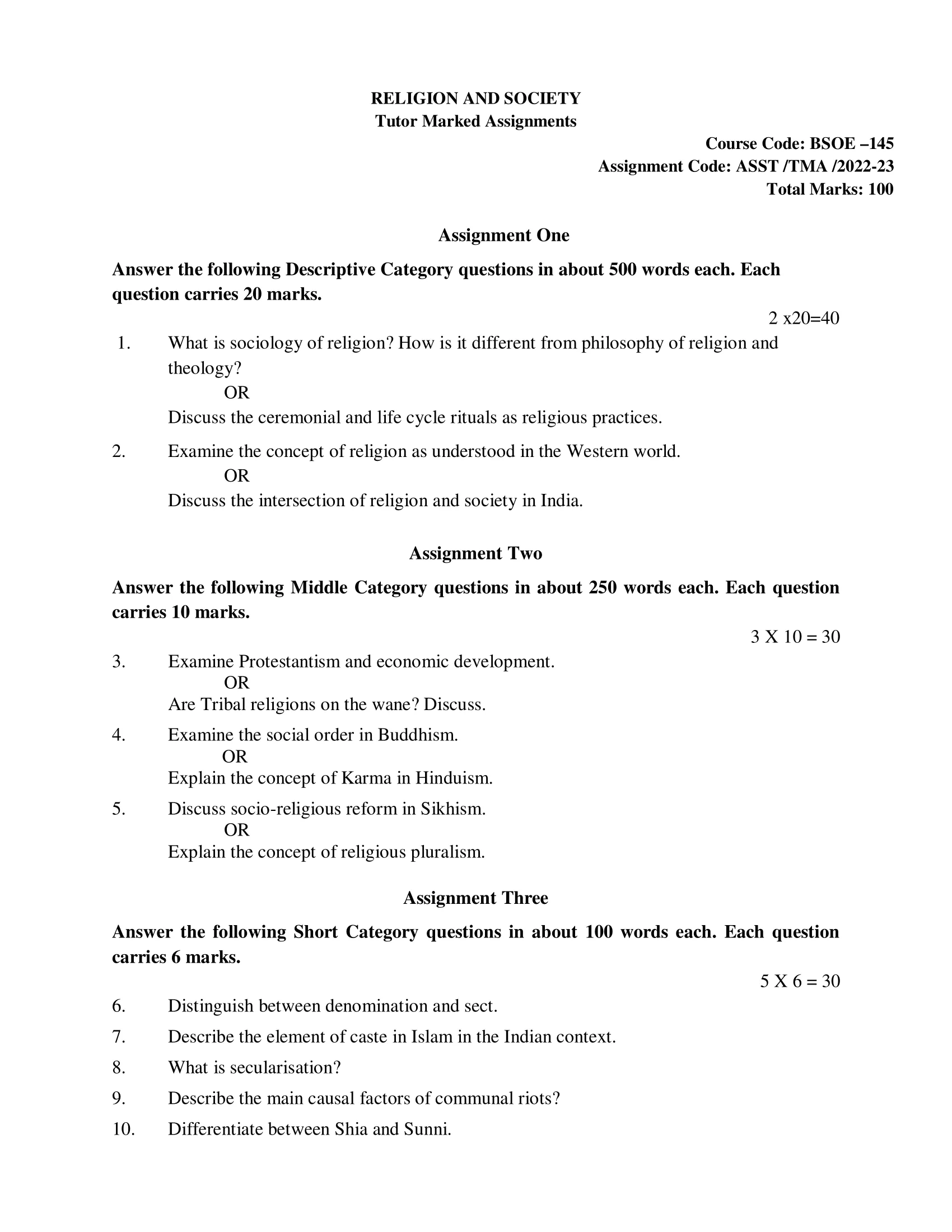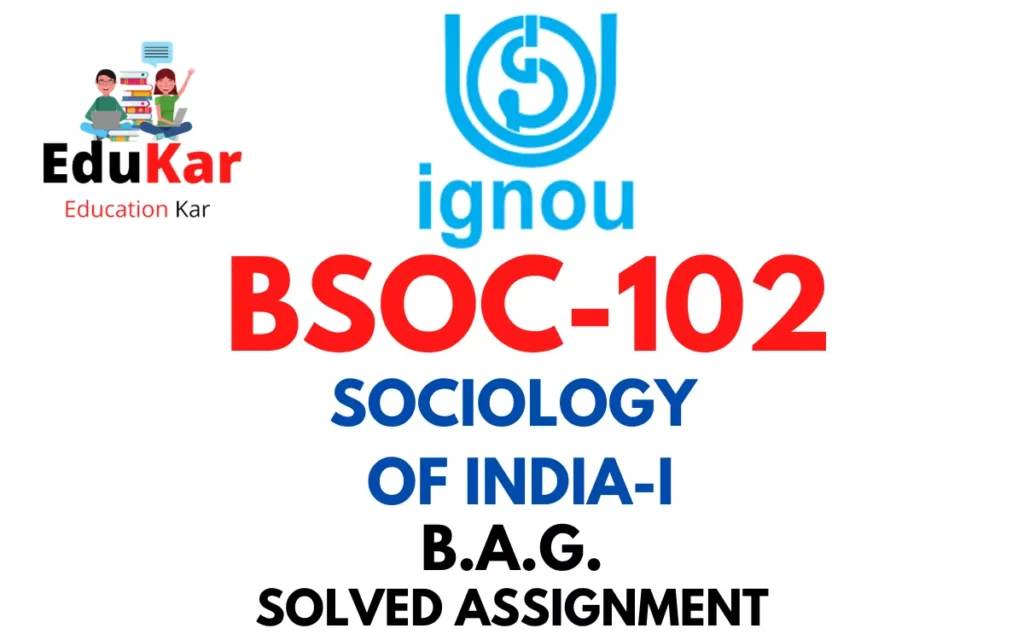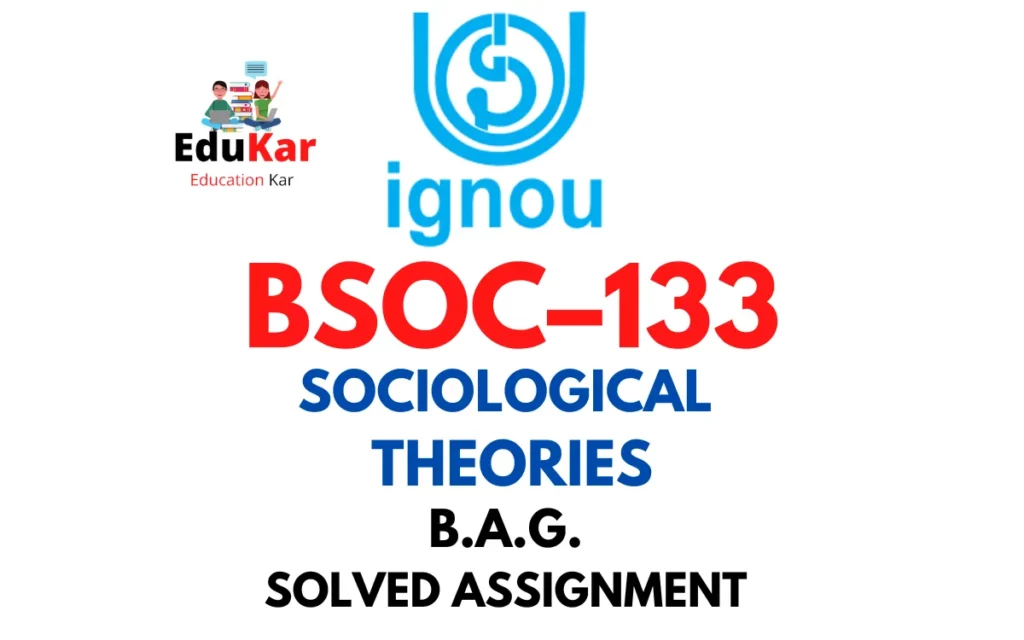Contents
- 1 Assignment One
- 2 Answer the following Descriptive Category questions in about 500 words each. Eachquestion carries 20 marks.
- 3 1. What is sociology of religion? How is it different from philosophy of religion andtheology?
- 4 Discuss the ceremonial and life cycle rituals as religious practices.
- 5 2. Examine the concept of religion as understood in the Western world.
- 6 Discuss the intersection of religion and society in India.
- 7 Assignment Two
- 8 Answer the following Middle Category questions in about 250 words each. Each question carries 10 marks.
- 9 3. Examine Protestantism and economic development.
- 10 Are Tribal religions on the wane? Discuss.
- 11 4. Examine the social order in Buddhism.
- 12 Explain the concept of Karma in Hinduism.
- 13 5. Discuss socio-religious reform in Sikhism.
- 14 Explain the concept of religious pluralism.
- 15 Assignment Three
- 16 Answer the following Short Category questions in about 100 words each. Each question carries 6 marks.
- 17 6. Distinguish between denomination and sect.
- 18 7. Describe the element of caste in Islam in the Indian context.
- 19 8. What is secularisation?
- 20 9. Describe the main causal factors of communal riots?
- 21 10. Differentiate between Shia and Sunni.

| Title | BSOE-145: IGNOU BAG Solved Assignment 2022-2023 |
| University | IGNOU |
| Degree | Bachelor Degree Programme |
| Course Code | BSOE-145 |
| Course Name | RELIGION AND SOCIETY |
| Programme Name | Bachelor of Arts (General) |
| Programme Code | BAG |
| Total Marks | 100 |
| Year | 2022-2023 |
| Language | English |
| Assignment Code | ASST /TMA /2022-23 |
| Assignment PDF | Click Here |
| Last Date for Submission of Assignment: | For June Examination: 31st April For December Examination: 30th September |

Assignment One
Answer the following Descriptive Category questions in about 500 words each. Each
question carries 20 marks.
1. What is sociology of religion? How is it different from philosophy of religion and
theology?
Ans: Sociology of religion is a subfield of sociology that focuses on the social and cultural dimensions of religion. It examines the role of religion in shaping society and culture, and how social factors such as class, race, and gender influence religious beliefs and practices. Sociology of religion is an empirical discipline that employs a range of research methods, including surveys, ethnography, and historical analysis.
Sociology of religion differs from both philosophy of religion and theology. Philosophy of religion is a branch of philosophy that examines the nature of religion and the existence of God. It focuses on philosophical questions about the meaning and truth of religious beliefs, rather than on social or cultural dimensions of religion. Philosophy of religion also tends to be more theoretical and abstract than sociology of religion, which is grounded in empirical research.
Theology, on the other hand, is a discipline that is concerned with the study of God and religious belief, particularly in a religious context. Unlike sociology of religion, which takes a secular approach to the study of religion, theology is often a religiously affiliated discipline. Theology tends to focus on the internal theological debates within a specific religion, while sociology of religion takes a more comparative approach, looking at how religion operates across different societies and cultures.
In summary, sociology of religion is a distinct field of study that examines the social and cultural dimensions of religion, while philosophy of religion and theology focus on the nature of religious belief and the existence of God. Sociology of religion employs empirical research methods, while philosophy of religion and theology tend to be more theoretical and abstract in nature.
OR
Discuss the ceremonial and life cycle rituals as religious practices.
Ans: Ceremonial and life cycle rituals are an essential component of religious practices in many cultures around the world. These rituals serve a variety of functions, including marking important life transitions, creating a sense of community, and establishing connections to the divine or supernatural.
Ceremonial rituals are religious practices that take place on specific occasions, often marking significant events or transitions in the life of an individual or community. These events can include holidays, festivals, and other special occasions. Examples of ceremonial rituals include the Hindu festival of Diwali, the Christian celebration of Easter, and the Jewish celebration of Hanukkah. These rituals often involve the use of music, prayer, dance, and other forms of expression, and they help to create a sense of community and shared identity among the participants.
Life cycle rituals, on the other hand, are religious practices that mark important transitions in an individual’s life. These rituals can include birth ceremonies, coming of age rituals, marriage ceremonies, and funeral rites. Life cycle rituals are often deeply ingrained in cultural traditions and can be powerful ways of connecting individuals to their communities and to the divine. Examples of life cycle rituals include the Christian sacrament of baptism, the Jewish bar mitzvah, and the Hindu wedding ceremony.
In addition to marking important life transitions, ceremonial and life cycle rituals also serve other important functions in religious practices. For example, they can help to establish a sense of continuity between past, present, and future, creating a link between individuals and their ancestors and descendants. They can also help to create a sense of order and structure in society, providing guidelines for behavior and reinforcing social norms and values.
Moreover, these rituals can also be seen as a way of creating a sense of transcendence, connecting individuals to something larger than themselves. By invoking the divine or supernatural, these rituals can help individuals to connect with a sense of purpose or meaning, and to establish a relationship with the sacred.
2. Examine the concept of religion as understood in the Western world.
Ans: The concept of religion in the Western world is complex and multifaceted, with a long and complex history that has evolved over time. The Western concept of religion is rooted in the Abrahamic religions of Judaism, Christianity, and Islam, which have played a dominant role in shaping Western culture and society. However, the concept of religion has evolved to encompass a wide range of beliefs, practices, and traditions, and has come to play a central role in the cultural and social fabric of many Western societies.
In the Western world, religion is typically understood as a system of beliefs and practices that involve a relationship with a supernatural or divine power. This relationship is often characterized by a sense of devotion or reverence, and may involve a range of rituals, prayers, and other forms of worship. The Western concept of religion is often associated with organized, institutionalized forms of belief, such as churches, synagogues, and mosques.
However, the Western concept of religion has also come to encompass a wider range of spiritual and philosophical beliefs and practices, including forms of spirituality that do not fit neatly into traditional religious categories. For example, practices such as meditation, yoga, and mindfulness have become increasingly popular in the Western world, often as a means of achieving personal growth and fulfillment.
The Western concept of religion has also been shaped by the legacy of colonialism, which brought Western religions and cultural values to other parts of the world. This legacy has influenced the way that religion is understood and practiced in many non-Western cultures, and has led to the development of new forms of syncretic religious traditions that blend elements of Western and non-Western beliefs and practices.
OR
Discuss the intersection of religion and society in India.
Ans: Religion and society are deeply intertwined in India, a country with a rich and diverse religious heritage that has played a central role in shaping the cultural, social, and political fabric of the nation. India is home to a wide range of religious traditions, including Hinduism, Buddhism, Jainism, Sikhism, Islam, and Christianity, among others. The interaction between these religious traditions and the broader social context has been complex and multifaceted, and has played a significant role in shaping the identity and cultural landscape of India.
One of the most significant ways in which religion intersects with Indian society is through the caste system, a hierarchical social system that has been deeply entrenched in Indian society for thousands of years. The caste system is closely tied to Hinduism, with each caste being associated with particular religious and occupational roles. While the Indian government has made efforts to dismantle the caste system, it continues to be a major force in Indian society, influencing social interactions and relationships, as well as political and economic power structures.
Religion also intersects with Indian society through political and social movements. For example, the Indian independence movement was closely tied to Hindu nationalism, with leaders such as Mahatma Gandhi and Vinayak Damodar Savarkar drawing on Hindu religious and cultural traditions to mobilize support for the struggle against British colonial rule. This legacy of Hindu nationalism has continued to shape Indian politics and society, with the rise of the Bharatiya Janata Party (BJP) and its Hindutva ideology in recent years.
Moreover, religion also intersects with Indian society through religious practices and rituals, which are deeply ingrained in the cultural fabric of the country. Religious festivals and rituals play a central role in Indian society, bringing people together and reinforcing social bonds. For example, the Hindu festival of Diwali is celebrated by people of all religions in India, and is a time of great joy and celebration. Other religious festivals, such as Eid for Muslims and Christmas for Christians, are also celebrated with great enthusiasm and are an important part of the cultural landscape of India.
Finally, religion intersects with Indian society through the provision of social services and charitable work. Religious institutions, particularly those associated with Hinduism, have long played a central role in providing basic social services such as healthcare, education, and food to the poor and marginalized. This has helped to create a sense of community and social cohesion, as well as providing vital support to those in need.
Assignment Two
Answer the following Middle Category questions in about 250 words each. Each question carries 10 marks.
3. Examine Protestantism and economic development.
Ans: The relationship between Protestantism and economic development has been a topic of interest for social scientists for decades. Max Weber, a German sociologist, first suggested in his book “The Protestant Ethic and the Spirit of Capitalism” that there was a connection between the Protestant work ethic and the rise of capitalism in Western Europe.
Protestantism, which emerged during the Reformation in the 16th century, placed a high value on individualism, hard work, and frugality. The Protestant work ethic emphasized the importance of working hard and saving money as a means of demonstrating one’s faith in God. This emphasis on hard work and discipline was seen as essential for success in both the spiritual and material realms.
Weber argued that this Protestant work ethic contributed to the development of capitalism in Western Europe. According to Weber, Protestant beliefs and values created a cultural climate that favored economic growth and development. Protestants were more likely to be self-disciplined and focused on their work, which made them more productive and successful in business.
However, other scholars have challenged Weber’s theory. They argue that there is no clear evidence to support the idea that Protestantism had a direct impact on economic development. Some have suggested that other factors, such as geography, politics, and culture, may have played a more significant role in shaping economic development.
Despite these debates, it is clear that Protestantism has played an important role in the development of modern capitalism. The values and beliefs that emerged during the Reformation continue to influence Western culture today, and they remain a key part of the cultural climate that supports economic growth and development.
OR
Are Tribal religions on the wane? Discuss.
Ans: The question of whether tribal religions are on the wane is a complex one that requires careful consideration of multiple factors. On the one hand, it is true that many tribal religions have experienced a decline in recent years. This can be attributed to a range of factors, including the influence of globalization, urbanization, and the spread of other religious traditions.
One of the major challenges facing tribal religions is the loss of traditional knowledge and practices. As younger generations move away from their ancestral lands and become more integrated into mainstream society, they may lose touch with their cultural heritage and spiritual practices. This can lead to a decline in the number of people who practice tribal religions, as well as a loss of traditional knowledge about these religions.
Another factor that has contributed to the decline of tribal religions is the influence of mainstream religions. As Christianity, Islam, and other religious traditions have spread around the world, they have often come into conflict with traditional tribal beliefs and practices. In some cases, tribal people have been forced to convert to these religions, leading to a decline in the practice of tribal religions.
However, it is important to note that not all tribal religions are in decline. In some parts of the world, particularly in areas with high levels of biodiversity and indigenous populations, tribal religions continue to be an important part of cultural and spiritual life. In some cases, these religions have even experienced a resurgence in recent years, as people seek to reclaim their cultural heritage and connect with traditional practices.
Furthermore, it is important to recognize that the concept of tribal religion itself can be problematic. The term “tribal” implies a degree of primitiveness or backwardness that is not necessarily accurate. Many tribal religions have complex belief systems and spiritual practices that are as sophisticated as those found in more mainstream religious traditions.
Ans: Buddhism is a religion that originated in ancient India and has since spread throughout Asia and beyond. At its core, Buddhism is focused on achieving enlightenment or Nirvana, which involves freeing oneself from the cycle of birth, death, and rebirth (samsara) and attaining a state of inner peace and wisdom. In order to achieve this state, Buddhism provides guidance on how to live a moral and ethical life, which has important implications for social order.
One of the key principles of Buddhism is the concept of the Eightfold Path, which outlines the steps that individuals must take in order to achieve enlightenment. This path includes elements such as right intention, right speech, right action, and right livelihood, which emphasize the importance of ethical behavior and the avoidance of harmful actions.
Another important concept in Buddhism is the idea of karma, which suggests that our actions have consequences that can impact our future lives. This means that individuals are encouraged to act in ways that are beneficial to others and to the world around them, in order to create positive karma and avoid negative consequences.
Buddhism also places a strong emphasis on compassion and empathy. The practice of metta, or loving-kindness, encourages individuals to cultivate a sense of love and compassion for all beings, regardless of their background or status. This promotes a sense of social responsibility and a desire to reduce suffering in the world.
The monastic tradition in Buddhism also has important implications for social order. Monks and nuns are expected to live a life of simplicity and detachment from material possessions, which is seen as a way to avoid the distractions of the material world and focus on spiritual practice. This can create a sense of social harmony, as individuals who have taken on this lifestyle are not competing for wealth or status.
Finally, Buddhism also places a strong emphasis on nonviolence and non-harm. This means that individuals are encouraged to avoid violence and conflict, and to seek peaceful resolutions to problems. This emphasis on nonviolence has important implications for social order, as it promotes a sense of harmony and respect for others.
OR
Explain the concept of Karma in Hinduism.
Ans: The concept of Karma is central to Hinduism and is one of the most important and widely recognized concepts in the religion. In Hinduism, karma refers to the idea that an individual’s actions, both good and bad, have consequences that affect their present and future lives. This means that every action, thought, and word has an impact on a person’s life and can shape their destiny.
The word karma comes from the Sanskrit word “karman,” which means “action” or “deed.” According to Hinduism, every action that a person takes creates a karmic debt that must be repaid in some way. Positive actions, such as helping others or performing religious rituals, generate good karma, while negative actions, such as lying, stealing, or harming others, generate bad karma.
The effects of karma are said to be cumulative, meaning that the consequences of one’s actions can accumulate over time and impact future lives. For example, if a person has generated a lot of bad karma in their current life, they may be reborn into a difficult or unhappy situation in their next life as a result of their actions.
In Hinduism, the ultimate goal is to break free from the cycle of birth, death, and rebirth, known as samsara, and attain moksha, or liberation from the cycle of reincarnation. This can be achieved by living a life of good karma, which involves performing positive actions and avoiding negative ones. By doing so, an individual can create a positive karmic balance that will lead to a more favorable future life and ultimately bring them closer to the goal of moksha.
It is important to note that the concept of karma in Hinduism is not deterministic. While a person’s actions may have consequences that shape their future lives, individuals also have the ability to make choices and change their karma through their actions. This means that it is possible to overcome negative karma by performing positive actions and making different choices.
5. Discuss socio-religious reform in Sikhism.
Ans: Sikhism is a monotheistic religion that originated in the Punjab region of India during the 15th century. The religion was founded by Guru Nanak, who taught that all people were equal and that God was present in everyone. Over the centuries, Sikhism has undergone various socio-religious reforms that have sought to promote equality and social justice.
One of the key social reforms in Sikhism was the rejection of the caste system. The caste system was a social hierarchy in India that categorized people into different groups based on their birth and occupation, and it was often used to justify discrimination and inequality. Sikhism rejected this system and emphasized the equality of all people, regardless of their background or status.
Another important socio-religious reform in Sikhism was the promotion of gender equality. Sikhism teaches that men and women are equal, and both can achieve salvation through their own efforts. The religion also rejected practices such as sati, in which a widow was expected to immolate herself on her husband’s funeral pyre, and purdah, in which women were required to cover their faces and bodies in public.
Sikhism also promoted social justice and the idea of seva, or selfless service. Sikhism teaches that individuals have a responsibility to help others, and that doing so is an important part of spiritual practice. This has led to a strong tradition of social welfare and community service in Sikhism, with many gurdwaras (Sikh temples) providing free meals and other forms of support to those in need.
In addition, Sikhism has undergone various religious reforms that have sought to simplify the religion and make it more accessible to the common people. For example, the Sikh gurus emphasized the importance of direct communication with God and rejected many of the rituals and practices that had become associated with traditional Hinduism.
OR
Explain the concept of religious pluralism.
Ans: Religious pluralism is the belief that there are multiple religions and spiritual traditions that can coexist and be valid simultaneously. This concept recognizes that different people may hold different beliefs about the divine or ultimate reality, and that each of these beliefs may have value and meaning.
Religious pluralism is often contrasted with religious exclusivism, which is the belief that one’s own religion is the only true path to salvation or enlightenment. Exclusivism may also hold that other religions are false or inferior. In contrast, religious pluralism holds that there are multiple paths to truth and that all religions have value and deserve respect.
One important aspect of religious pluralism is tolerance. Tolerance means that individuals and communities can accept and respect the beliefs and practices of others, even if they differ from their own. This can help to promote peace and understanding among different religious groups.
Another aspect of religious pluralism is dialogue. Dialogue involves a respectful and open exchange of ideas between people of different religions. Through dialogue, individuals can learn from one another, find common ground, and build relationships that can lead to greater understanding and cooperation.
Religious pluralism is also related to the idea of interfaith cooperation. Interfaith cooperation involves people of different religious backgrounds working together towards common goals, such as social justice, environmental sustainability, or peacebuilding. This can help to break down barriers between different religious communities and promote greater understanding and collaboration.
Assignment Three
Answer the following Short Category questions in about 100 words each. Each question carries 6 marks.
6. Distinguish between denomination and sect.
Ans: In the study of religion, a denomination is a subgroup within a larger religion that shares a set of beliefs, practices, and organizational structures, but is distinct from other subgroups within the same religion. Denominations often have a formal organizational structure, with established leadership and governance, and may have their own distinct doctrines, rituals, and traditions.
In contrast, a sect is a small, relatively new religious group that often emerges in response to perceived shortcomings or conflicts within an existing religious tradition. Sects typically have a charismatic leader and a strong sense of communal identity, and often hold beliefs and practices that are at odds with those of the larger religious tradition from which they emerged. Unlike denominations, sects often lack a formal organizational structure and may be viewed as deviant or heretical by the larger religious community.
7. Describe the element of caste in Islam in the Indian context.
Ans: Caste is a social and occupational hierarchy that has long been entrenched in Indian society, particularly in the Hindu community. While Islam does not have a formal caste system, the social and economic structures of Indian society have meant that caste-based discrimination and stratification have often been carried over into the Muslim community.
In the Indian context, there are several ways in which caste has intersected with Islam. One of the most significant is through the continued influence of pre-Islamic caste-based practices and beliefs, particularly among converts from Hinduism to Islam. These converts may continue to identify with their caste, and may even retain caste-based occupations and practices, despite the fact that Islam does not recognize caste as a legitimate basis for social stratification.
Moreover, the Indian Muslim community is not homogeneous, but is instead made up of numerous ethnic and linguistic groups, many of which have their own distinct caste-based traditions and practices. This has meant that caste-based discrimination and exclusion can occur within the Muslim community, particularly with regard to marriage and social interaction.
Efforts have been made to address the issue of caste in the Indian Muslim community, both by Muslim organizations and by the government. For example, some Muslim organizations have advocated for the abolition of caste-based practices and beliefs, and have worked to promote greater social and economic equality within the community. The government has also taken steps to address caste-based discrimination in the Muslim community, including by providing affirmative action programs for lower-caste Muslims.
8. What is secularisation?
Ans: Secularization is a complex and multifaceted process that refers to the decline in the influence of religion in various aspects of society, including politics, culture, and everyday life. It involves a shift away from religious authority and belief, and toward more secular ways of understanding the world.
In its broadest sense, secularization refers to the historical and social forces that have led to the decline of religion as a dominant social and cultural institution in the modern world. This can include factors such as the rise of science and technology, the growth of secular education and institutions, and the increasing importance of individual autonomy and rationalism.
In more specific terms, secularization can refer to a number of different trends and phenomena, including the decline in church attendance and religious affiliation, the rise of secular ideologies and political movements, the increasing importance of individualism and consumer culture, and the erosion of traditional religious values and practices.
Some scholars argue that secularization is an inevitable and irreversible process that will ultimately lead to the disappearance of religion from modern societies. Others argue that religion will continue to play an important role in the lives of individuals and communities, even as its influence declines in certain areas of society.
9. Describe the main causal factors of communal riots?
Ans: Communal riots are violent conflicts that occur between different religious or ethnic communities, often resulting in injury, death, and destruction of property. The causes of communal riots are complex and multifaceted, and can vary depending on the specific context and historical background. However, some of the main causal factors of communal riots are as follows:
- Political factors: Communal riots can be sparked or exacerbated by political leaders who use religion or ethnicity to mobilize their supporters for political gain. This can lead to the demonization of other communities and a breakdown in inter-community relations.
- Socioeconomic factors: Economic disparities and marginalization can create a sense of frustration and resentment among certain communities, leading to communal tension and conflict. In some cases, communal riots may be fueled by competition over resources, such as land or jobs.
- Historical factors: Past events, such as colonialism, partition, or past communal violence, can create deep-seated animosity and mistrust between different communities, which can be reactivated in times of tension or conflict.
- Cultural factors: Differences in language, customs, and religious practices can lead to misunderstandings and conflicts between different communities.
- Religious factors: Communal riots can be sparked by religious tensions, including perceived insults to religious figures, desecration of religious symbols or places of worship, and attempts at religious conversion.
- Law and order factors: Inadequate or biased law enforcement can exacerbate communal tensions and provide a breeding ground for communal riots. In some cases, communal riots may be sparked by police brutality or failure to protect vulnerable communities.
These factors are interrelated and complex, and the causes of communal riots are often the result of a combination of these factors.
10. Differentiate between Shia and Sunni.
Ans: Shia and Sunni are the two main branches of Islam. The primary difference between the two is their understanding of the succession of the Prophet Muhammad. Sunni Muslims believe that the first four caliphs (Abu Bakr, Umar, Uthman, and Ali) were rightly guided and that the caliphate should follow the consensus of the community. Shia Muslims believe that the leadership of the Muslim community should belong to the family of the Prophet Muhammad and that the first Imam was Ali, his cousin and son-in-law. Shia Muslims also have different practices and rituals, such as mourning the martyrdom of Ali’s son, Hussain, during the Day of Ashura.
How to Download BSOE-145 Solved Assignment?
You can download it from the www.edukar.in, they have a big database for all the IGNOU solved assignments.
Is the BSOE-145 Solved Assignment Free?
Yes this is absolutely free to download the solved assignment from www.edukar.in
What is the last submission date for BSOE-145 Solved Assignment?
For June Examination: 31st April, For December Examination: 30th October







![[Solved Assignment] BPCS 188-APPLICATIONS OF SOCIAL PSYCHOLOGY (IGNOU-BAG) 2022-2023 BPCS 188-APPLICATIONS OF SOCIAL PSYCHOLOGY IGNOU BAG Solved Assignment 2022-2023](https://edukar.in/wp-content/uploads/2023/01/BPCS-188-APPLICATIONS-OF-SOCIAL-PSYCHOLOGY-IGNOU-BAG-Solved-Assignment-2022-2023-1024x640.webp)








